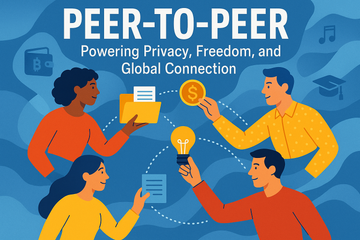Let’s paint a quick picture. Imagine you’re at a lively swap meet, and each person is both a buyer and a seller, trading goods, services, or even stories, face to face, no middleman needed. That’s pretty much the vibe of a peer-to-peer (P2P) network—minus the haggling over antique spoons, thankfully. At its heart, P2P is all about sharing directly, freely, and with a surprising amount of trust. Now, let’s roll up our sleeves and really see why this concept has gone from a tech buzzword to a blueprint shaping everything from crypto wallets to community learning circles.
Why All the Fuss? The Core of P2P
P2P’s magic touch is its lack of a commanding “boss.” Instead of shuffling everything through a central hub (like how banks handle payments), each participant—called a peer—can offer or request resources straight from anyone else. So, in technical lingo, these networks flatten the hierarchy and let every member be both a giver and a taker at any moment. Napster, that old-school music-sharing darling, set the tone in the late 1990s. It wasn’t just about swapping mp3s; it was a revolution in how data zipped around the world—straight from my computer to yours.
P2P in Crypto: Skipping Middlemen and Taking Charge
You know what? The crypto crowd really took P2P to heart. Talk about cutting the cord on centralized control! Bitcoin and its blockchain cousins wouldn’t even exist without P2P networks quietly humming in the background. Here, every participant (or node) helps verify and record transactions, meaning your digital wallet doesn’t rely on a single institution for security. That’s huge if you care about censorship-resistance or privacy.
Take Ledger and Trezor hardware wallets. They’re the gold standard in crypto storage for a reason. Sure, they aren’t networks themselves—but they plug you, the individual, right into the decentralized ecosystem, letting you interact securely with peer-powered blockchains. It’s like keeping your cash in a vault you own, with the added bonus of being able to transact with anyone around the globe, anytime, no permission slips required.
Junebugs, Indie Music, and File Sharing: P2P’s First Claim to Fame
Quick detour—a little nostalgia never hurt. Anyone who remembers the Napster or LimeWire days probably has a pang of guilt (or pride) about their music collection. Those early P2P file-sharing giants gave us the power to access music, movies, and more with just a click. It was intoxicating and, yes, controversial. The studios weren’t thrilled, but the underlying technology proved there’s a wild hunger for open, direct exchange. Today, BitTorrent carries that torch, distributing everything from indie games to open-source software using, you guessed it, P2P networks.
What About Beyond Tech? P2P Is a Way of Life
This whole peer-driven model isn’t just digital. Fun fact: P2P ideas even power grassroots community groups and innovative education programs. In some schools, 'Peer to Peer' projects match students together to build skills, share experiences, and learn through doing, not just listening. It’s collaboration without the top-down structure—just like the best kinds of friendships.
How’s It Different from the Boring Old Client-Server Way?
Let me explain using an analogy. Traditional networks are like a fast-food joint: you’ve got cooks in the back (the server) and a long line of hungry customers (clients). If the kitchen goes out, no one eats. But in P2P, everyone brings a dish to a potluck—there’s plenty to go around, and if one person leaves early, the party keeps going. In tech terms, P2P networks are self-sustaining, robust, and harder to take down.
A Few Qualities That Make P2P Shine
- No Single Point of Failure: With no central server, there’s no glaring target for cyberattacks or outages.
- Cost Conscious: Less money spent on big, centralized servers. Everyone pitches in a share.
- Privacy Perks: Since you’re dealing directly with other users, there’s a bit more privacy—great for crypto or sensitive data sharing.
- Global Reach: Your peer could be your neighbor or someone halfway across the world; distance fades in a good P2P network.
Real Talk: It’s Not All Sunshine and Rainbows
Now, before you start dreaming up the next killer P2P project, let’s address the quirks. Some folks worry about accountability. If anyone can connect, some bad apples might slip through. File-sharing networks struggled with copyright headaches, and P2P payment apps, while fast, can leave users at risk if disputes arise. Plus, the lack of central authority means you need trust—or robust cryptography (hello, Trezor and Ledger again)—built into the design. Sometimes updates can lag, and troubleshooting turns into a group project. Still, that’s a small price for freedom, right?
Cultural Ripples and Everyday Analogies
Sometimes, technology shapes culture in ways we barely notice. P2P’s spirit shows up in carpooling apps and local trading groups. Fans of decentralized media often compare these networks to old-fashioned barn raisings or communal harvests—everyone shows up, everyone benefits, and, honestly, it’s more fun when you’re not waiting in line. Even community-run events, like farmer’s markets, echo this model: peers, meeting on level ground, exchanging without a head honcho.
Wrapping Up: Is P2P the Future, or Just a Fad?
Let’s be real: P2P isn’t perfect, but it’s powerful by design. Its influence spans from the file-sharing fevers of the early 2000s to the shielded crypto transactions of today. Whether you’re locking down your coins with a Ledger, swapping files over BitTorrent, or joining a school project built on shared effort, you’re already part of the movement.
As digital communities grow and the call for privacy and autonomy gets louder, P2P’s flexible, egalitarian style feels more like a necessity and less like a novelty. So next time you fire up a crypto wallet or join a local tool-swap, you’re not just trading bytes or belongings—you’re channeling the open, contagious energy of peer-to-peer.











